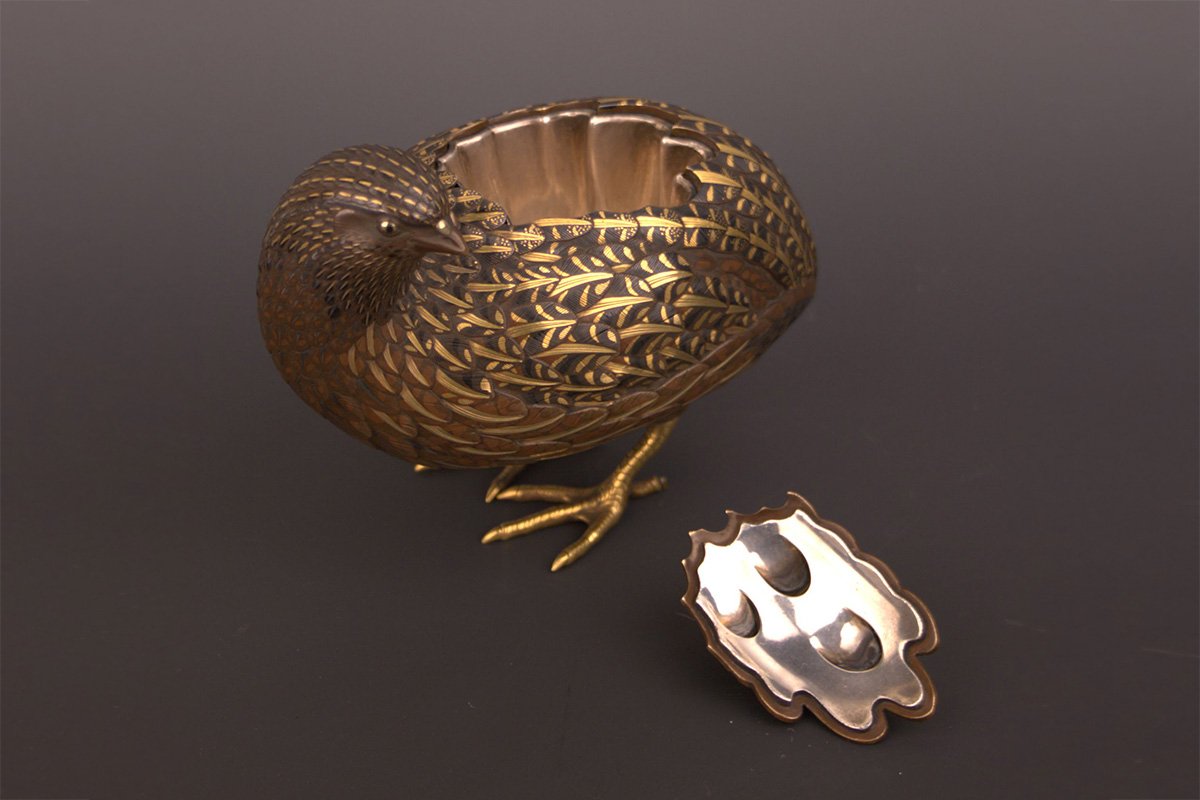MEIJI-TAISHO
MITO SCHOOL, INLAID QUAIL OKIGORO
Okigoro or figural incense burner in the form of a quail pausing to glance over its shoulder. Of cast, carved, and cold-chiseled bronze, inlaid extensively with irregular inlays in gold, pink gold, shakudo, shibuichi, silver, and red bronze; the feet of cast bronze, cold-chiseled and gilt; the fluted incense well of hammered silver. Unsigned, Mito School metalwork. With the original, black lacquered oval display stand. Meiji era, late 19th – early 20th century.
With a fitted, period storage box of paulownia wood.
This masterpiece of metal carving and inlay work staggers the eye and mind. Multiple inlays detail every feather. Where lavish inlays of bright gold curve like scimitars across the back, other inlays of shibuichi contrast with shakudo to frame and mottle the plumage. The scale grows and lessens with the scale of the feathers. Tiny dots of gold spot the back and tail. Fine mottling of shibuichi details the under plumage, warmed across the breast with subtly warm-toned, pink gold inlays. Gold quills give way to silver on the neck and under plumage. On both sides as the under-plumage points to the tail it greys in shibuichi, the shibuichi itself inlaid with hemispheres of shakudo.
We are unconvinced that the body of the bird was cast, rather than carved entirely from bronze. Even were the body first cast, traces of carving with gilding soften the interior, visible to the eye when the silver incense well is removed. The entire exterior of the quail was carved from bronze and then inlaid in carved inlays from one end to the other in brilliant gold and shakudo softened by subtle shades of shibuichi, pink gold and red bronze.
The spectacular artistry of this quail suggests to us two Mito School artists. While Hagiya Katsuhiro possessed the skills, he worked in earlier decades than those that would have seen such a koro made. Fine silver incense wells and baffles on the reverse of incense burner lids do not seem to appear until the end of the 19th and first years of the 20th century. As well, the period box displays a patina consistent with those decades rather than earlier ones. Unno Moritoshi comes to mind, as well as Unno Shomin. Both created work with wonderful inlays and both made three dimensional sculptural pieces. A famous pair of vases in the Imperial Collections by Shomin with falcons and the sea makes an interesting comparison. Those date to 1909 and are illustrated in Metal Carving of the Meiji Era: Unno Shomin and His Vicinity, published by The Museum of the Imperial Collections, number 25, pages 62 – 63. The close-up of the inlay work on the wings reveals very similar shibuichi and shakudo inlays to those on this koro. Curving, magatama or comma shapes detail the plumage subtly like those on this quail. Unno Shomin’s work also reveals an instinct for elegant naturalism rather more than most of his contemporaries. Still, whatever hand made this masterpiece, whose will always be a matter of speculation.
This quail may have graced an imperial tokonoma. The refined and unmatched quality of the workmanship, lavish use of precious metals, and spectacularly fine scale are the work of only one of a handful of the best Mito School artists. By the last decades of Meiji, Imperial artists signed most of their work. For only the highest, most personal of royal commissions would such a quail have been let to stray without a tethering signature.
Mito School, Inlaid Quail Okigoro
Period: Meiji Taisho
Mediums: Metalwork
Form: Koro or Incense Burners, Okimono or Sculpture
Origin Country: Japan
3 ½” high x 4 1/8” long x 2 3/8” deep
This piece is no longer available.






